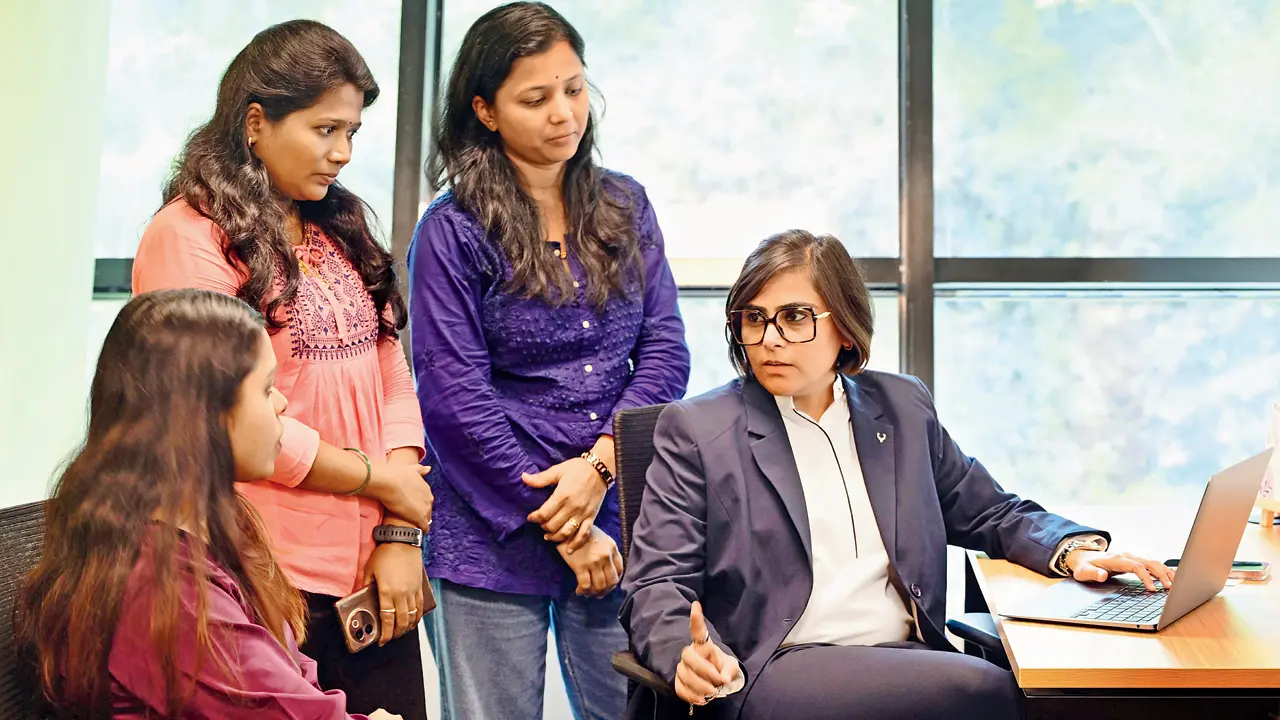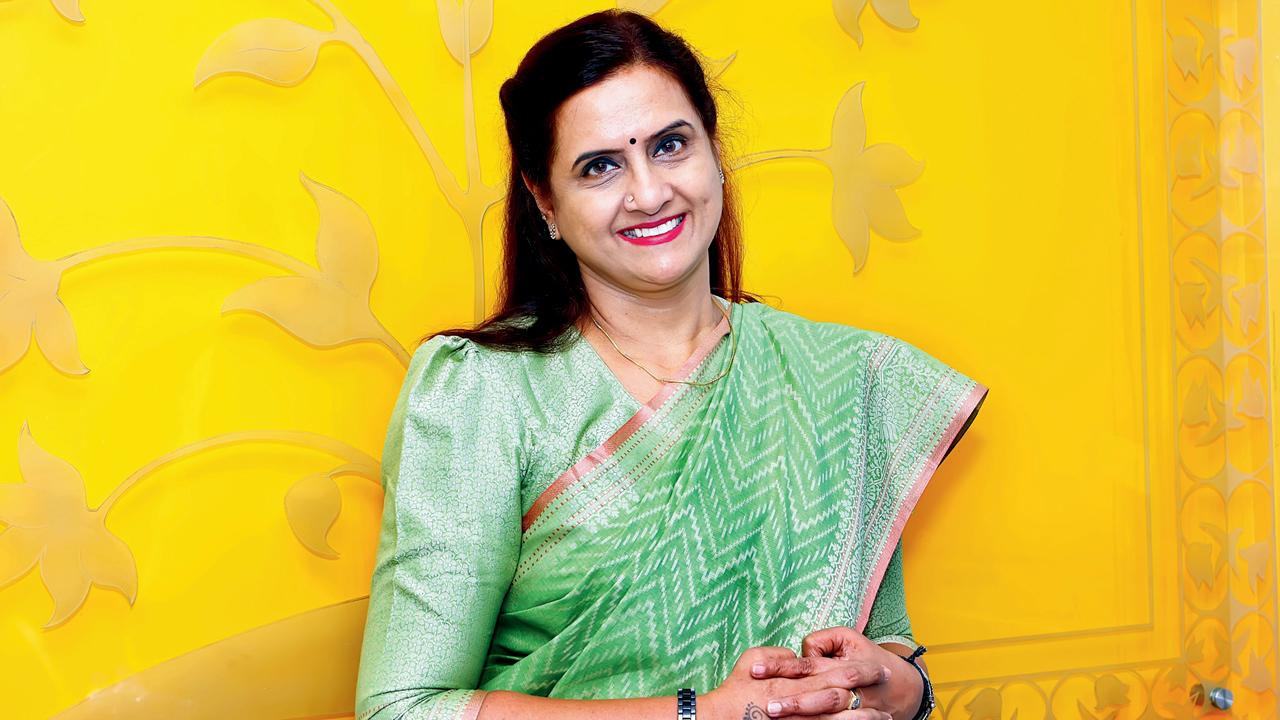We’ve always known this, but with a new study out, there’s empirical evidence for it: Women have a steeper climb to the top of the career ladder. And, this stagnation in mid-level roles is driving a devastating brain drain — the great resignation of women

Dipali Padia (right) now uses her influence and experience to mentor younger women at her workplace. Pic/Nimesh Dave
I put in my papers last week,” Varsha Ramani (name changed), 38, an advertising executive from Chembur, tells us over a phone call. “I will never again be held back by a man who’s less competent than me. I know it’ll be hard, but I’m going to start my own firm.”
Ramani has worked on the client servicing end of the advertising field for 15 years. She also worked closely on ideating and executing creative campaigns — without credit. “When I asked for a formal role change to the creative side, I was turned down citing my lack of experience. Then I saw the same managerial role go to a man six years my junior, and he’d worked on fewer campaigns than me. It felt like I was just running at top speed, never moving forward.”
She’s not the only woman who finds her career in the doldrums, while men around her zoom to the top.
In its annual research series “Women in the Workplace”, conducted for the first time in India, McKinsey & Company found that men here are 2.4 times more likely to be promoted to managerial roles in a given year compared to women. The same report has found that Indian women can be stuck in entry-level and mid-level roles up to seven years longer than men, with the average transition age for women being 39, compared to 32 for men, before they move up to leadership roles.
What does this mean? It’s something that we’ve always known, but finally have empirical evidence for: the climb to the top is steeper for women. It’s driven by systemic biases — inequitable distribution of domestic labour, gender assumptions (such as presuming a woman will not be as committed to work as a man), pay disparity — take your pick.
The gender gap isn’t just about fewer women being hired; it’s about why they leave. On paper, it might look like women like Ramani are leaving of their own volition; what remains invisible is the systemic barriers that keep them from achieving their leadership aspirations, slowly pushing them out. This phenomenon is called the “broken rung”.
It’s no coincidence that a 2023 study by CNBC-TV18 and the Federation of Indian Chambers of Commerce and Industry found attrition rates are highest among women in the 20-30 age group (15 per cent), and the 30-40 age group (13 per cent). “Many women take a career break at this stage to build a family. Because, one, women shoulder most unpaid care work [child-raising, caregiving]. Two, in a couple, if the man’s career is progressing, and the woman’s is not, it makes financial sense for the woman to step back. A couple of years later, the wife returns for her second innings, only to find the opportunities have shrivelled,” says Mitali Nikore, feminist economist and founder of policy think tank Nikore Associates.
This aligns with findings in the McKinsey report, which states that women are 1.3 times more likely than men to quit their workplace during the long climb to the leadership rungs. Once they make it there, though, particularly the C-suite (CEO, CFO, and so on), women and men are on even footing; promotions increase and attrition falls. This makes sense: when rewarded, women stay and perform.
And the women who quit, where do they go? Onward and upward! While many do devote themselves to marriage and child-raising duties, Sunday mid-day spoke to several women who have gone on to set up their own successful enterprises, or moved on to jobs that recognised their value and gave them the promotions they deserve.
Barriers to dreams of leadership
41%
The extent to which family duties serve as a barrier
23%
The gender bias barrier
13%
Lack of mentorship barrier
‘I’m here to build a better ladder’
Dipali Padia, 37,
worked her way up in the fintech industry
Experience: 16 years
After starting her career in the male-dominated banking sphere, Dipali Padia moved on to the more modern fintech space, only to find the old boys’ club at play there too.
Over the years, Padia has climbed to the top of the field and is now Director of Business Development & Banking Alliances at the Powai-based fintech firm, Neokred. Padia is proud of where she’s reached — “I’ve earned my position, and I enjoy my privileges no less than any man” — but rues, “My climb surely would have been faster if I were a man, who are we kidding?”
“There were times when I led revenue growth for a product vertical, over delivered on KPIs, and still watched as senior roles were quietly handed to male peers with less consistent track records,” she recalls. “The reason? ‘He has a certain presence’. That presence, I realised, was often code for social comfort — who could talk freely in after-hours settings, who could bond on after-work offsites. These unspoken access points are rarely designed for working women juggling dual responsibilities.
“The gap is real and systemic. It shows up in subtle ways; who gets invited to strategic conversations, who’s assumed to have leadership potential, who’s ‘encouraged’ to take client-facing roles, and who’s expected to hold the fort quietly. The McKinsey data puts numbers to what has long been felt: women are often not lacking in capability, but rather in advocacy.
“I used to think results speak for themselves. But in our corporate environment, performance often needs packaging, and women are socially conditioned not to self-promote. I had to learn how to speak about my wins, claim space in strategic discussions, and say no to token roles that didn’t serve my long-term goals.”
Now, Padia is focused on using her influence to open doors for the next generation of women. “I didn’t climb the ladder just to survive at the top. I’m here to build a better ladder.”
“I’ve made it a point to mentor younger women, create visibility for their wins, and question outdated assumptions in boardroom conversations. Internal sponsorship, flexible role design, a proactive returnship programme: these are some of the moves we’ve initiated at Neokred. Research shows women’s voices are interrupted or sidelined 33 per cent more often in meetings, so I make a deliberate effort to bring them into conversations repeatedly, ensuring their ideas influence decision-making.”
‘Any woman can come get a seat at this table’

Sangita Marda Agarwal
Network leader for support community, Lean In Mumbai
When life pushed me down — separated from an abusive husband, with two daughters to support — it was two women who showed the way to a work opportunity and mentored me,” says Sangita Marda Agarwal, a communications consultant with 29 years’ experience who is also the Network Leader for Lean In Mumbai (@leaninmumbai). In this community, women at any stage of their career can find peer-to-peer mentorship, camaraderie, and support. Affiliated to the international Lean In network established by former Meta CEO Sheryl Sandberg, the Mumbai chapter connects about 2500 women through its website and LinkedIn, and another 450 women on a WhatsApp group.
“One of the reasons I started Lean In Mumbai eight years ago was to pay forward the kindness of those women. I pivoted my career and moved to Mumbai but I struggled for a sense of belonging and to get a seat at the table. I decided to build a table myself. A table so big that any woman here can just pull up a seat, and feel like they belong.
“Imagine a world with not just the old boys’ club, but one for the girls too. With that kind of mentorship and networking, this could very well be a woman’s world,” she says.
‘Women are asked repeatedly to prove themselves’

Nitasha Berry, 37,
Events head at a Bengaluru firm, changed jobs to land a promotion she was denied
Experience: 11 years
Last year, at the age of 36, Nitasha Berry broke into the leadership level, making events head at her current workplace. But that was only after she switched jobs. “At the previous company, I had a decade of experience, but they gave me a junior designation. Then I applied to a UK-based company and they looked at my experience and talent and gave me the division head title, no questions asked. It was eye-opening for me. This is how it should have been all along,” she says.
She proved herself immediately, pulling off a large-scale conference in London for 3000 people within three months, with no team save for two interns. “That’s the kind of thing a woman can do with limited resources. And that’s the woman my previous company denied the same opportunity,” she says.
She adds that she held on to the title when she moved to the Bengaluru company she now works at. Appreciated as it is, the recognition has come much later that it did for her male peers. “In my industry, on average, men are promoted to the same designation when they are 26-27. Men can sell air and they will still get promoted. They can fail up, while women are asked to prove themselves repeatedly, and are still denied.”
‘There was no room to grow’

Priyanka Chandra, 34,
started her own Entertainment PR firm
Experience: 10 years
A little over five years into her Entertainment PR career, Priyanka Chandra started to feel stifled in her former workplace. “Sometimes it felt like a lot of opportunities were not coming my way, maybe because I was a woman,” she recalls.
“The better I did, the more I found insecure male colleagues blocking my access to clients. There was no room to grow. So I decided to get out and start my own firm,” says Chandra, who went on to found Mulberry Media four years ago. They now represent actors, film festivals, screenwriters, cinematographers and more.
“The workplace is full of assumptions, from thinking of women as lesser than, to questioning whether a woman can handle fieldwork. Or the assumption of what one can ask a woman to do — a friend told me her employer, a man, asked her to meet an actor after work hours for a coffee or whisky to ‘gel with him’. She ended up quitting,” fumes Chandra.
It’s not just the men playing into patriarchy; when there are few opportunities to begin with, it pits women against each other too, and nobody wins, says the film and celebrity consultant.
Branching out on her own, Chandra says, has been life-changing. “IF a woman feels her capabilities are being stunted for whatever reason, be it politics or men restricting her growth, they should branch out on their own. It’s an act of courage, but the moment you stand up for yourself, it feels amazing,” she says.
Fixing a lose-lose situation
There is a solution to empower the female gender at work, and it includes health support and leadership development programmes
 Dr Saundarya Rajesh
Dr Saundarya Rajesh
We're pushing smart women out of structured systems into solopreneurship or early burnout… because the equation simply stopped making sense: work 2x harder, get 50 per cent of the recognition, all while carrying 100% of the invisible load at home. It’s one of the most quietly devastating losses in corporate India,” says Dipali Padia, Director of Business Development & Banking Alliances, Neokred.
It’s a bigger loss for the organisation and economy. The cost of replacing a mid-to-senior level employee can be 1.5 to two times their annual salary. And that’s not counting the cultural loss of losing experienced women employees, who often hold teams together and mentor the younger members. The IMF in 2015 estimated that gender parity in the workforce could boost the country’s GDP by a whopping 27 per cent.
Employers must deploy gender-neutral solutions like “flexible work arrangements, work-life integration programmes, and parental leave, to all employees, irrespective of gender. This will help level the playing field,” says Dr Saundarya Rajesh, Founder-President of the Avtar Group, which works towards Diversity, Equity and Inclusion (DEI).
Dr Rajesh, who set up Avtar after her own struggle returning to work following a career break for motherhood, emphasises that it’s mid-career women who fall through the cracks the most. “Organisations tend to focus on entry-level women and young moms, with returnship programmes, childcare support, inclusive onboarding. We need to realise that women need sustained support, in the form of women’s leadership development programmes, Employee Resource Groups, health support to prevent burnout, and gender bias training,” she says.
For men, choosing or prioritising between career or family is never even a question. “Women frequently choose a job solely because it allows us to juggle family responsibilities alongside our work duties. We must go for the career that yields influence! Use career intentionality as a force to tackle the inequitable system,” she says.
 Subscribe today by clicking the link and stay updated with the latest news!" Click here!
Subscribe today by clicking the link and stay updated with the latest news!" Click here!










